Evaluating Social Networking Websites for Recruitment: HRM Report
VerifiedAdded on 2023/04/21
|13
|3744
|291
Report
AI Summary
This report presents a comprehensive research methodology for evaluating the efficacy and experience of using social networking websites for recruitment within selected information technology organizations. The research employs a mixed-methods approach, incorporating both quantitative and qualitative data collection and analysis techniques. The methodology section outlines the research philosophy (pragmatism), approach (deductive), strategy (primary data collection through surveys and interviews), design (sequential explanatory), and methods (reliability and validity checks). The sampling framework details the target population, sampling frame (IT companies in Australia), sample sizes (200 employees for quantitative analysis, 5 managers for qualitative analysis), and sampling methods (simple random sampling for quantitative data and convenience sampling for qualitative data). The data analysis framework utilizes SPSS for quantitative analysis, generating response frequencies, graphs, and descriptive and inferential statistics, while qualitative data is analyzed through structured interviews of human resource managers. The report aims to provide a detailed and replicable methodology for similar studies in the field of human resource management.

Running head: HUMAN RESOURCE MANAGEMENT
Human Resource Management
Name of the student
Name of the university
Author note
Human Resource Management
Name of the student
Name of the university
Author note
Paraphrase This Document
Need a fresh take? Get an instant paraphrase of this document with our AI Paraphraser
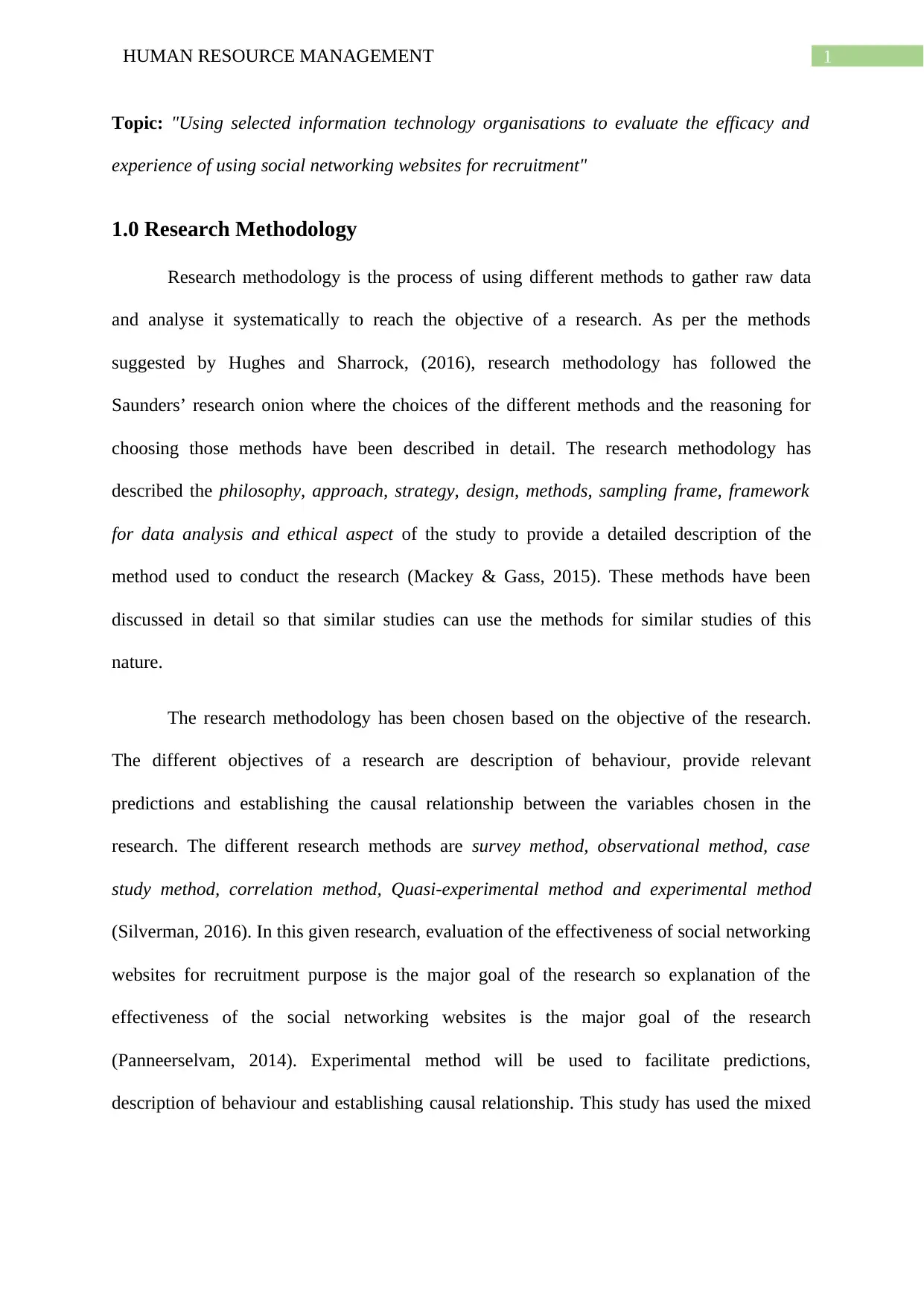
1HUMAN RESOURCE MANAGEMENT
Topic: "Using selected information technology organisations to evaluate the efficacy and
experience of using social networking websites for recruitment"
1.0 Research Methodology
Research methodology is the process of using different methods to gather raw data
and analyse it systematically to reach the objective of a research. As per the methods
suggested by Hughes and Sharrock, (2016), research methodology has followed the
Saunders’ research onion where the choices of the different methods and the reasoning for
choosing those methods have been described in detail. The research methodology has
described the philosophy, approach, strategy, design, methods, sampling frame, framework
for data analysis and ethical aspect of the study to provide a detailed description of the
method used to conduct the research (Mackey & Gass, 2015). These methods have been
discussed in detail so that similar studies can use the methods for similar studies of this
nature.
The research methodology has been chosen based on the objective of the research.
The different objectives of a research are description of behaviour, provide relevant
predictions and establishing the causal relationship between the variables chosen in the
research. The different research methods are survey method, observational method, case
study method, correlation method, Quasi-experimental method and experimental method
(Silverman, 2016). In this given research, evaluation of the effectiveness of social networking
websites for recruitment purpose is the major goal of the research so explanation of the
effectiveness of the social networking websites is the major goal of the research
(Panneerselvam, 2014). Experimental method will be used to facilitate predictions,
description of behaviour and establishing causal relationship. This study has used the mixed
Topic: "Using selected information technology organisations to evaluate the efficacy and
experience of using social networking websites for recruitment"
1.0 Research Methodology
Research methodology is the process of using different methods to gather raw data
and analyse it systematically to reach the objective of a research. As per the methods
suggested by Hughes and Sharrock, (2016), research methodology has followed the
Saunders’ research onion where the choices of the different methods and the reasoning for
choosing those methods have been described in detail. The research methodology has
described the philosophy, approach, strategy, design, methods, sampling frame, framework
for data analysis and ethical aspect of the study to provide a detailed description of the
method used to conduct the research (Mackey & Gass, 2015). These methods have been
discussed in detail so that similar studies can use the methods for similar studies of this
nature.
The research methodology has been chosen based on the objective of the research.
The different objectives of a research are description of behaviour, provide relevant
predictions and establishing the causal relationship between the variables chosen in the
research. The different research methods are survey method, observational method, case
study method, correlation method, Quasi-experimental method and experimental method
(Silverman, 2016). In this given research, evaluation of the effectiveness of social networking
websites for recruitment purpose is the major goal of the research so explanation of the
effectiveness of the social networking websites is the major goal of the research
(Panneerselvam, 2014). Experimental method will be used to facilitate predictions,
description of behaviour and establishing causal relationship. This study has used the mixed
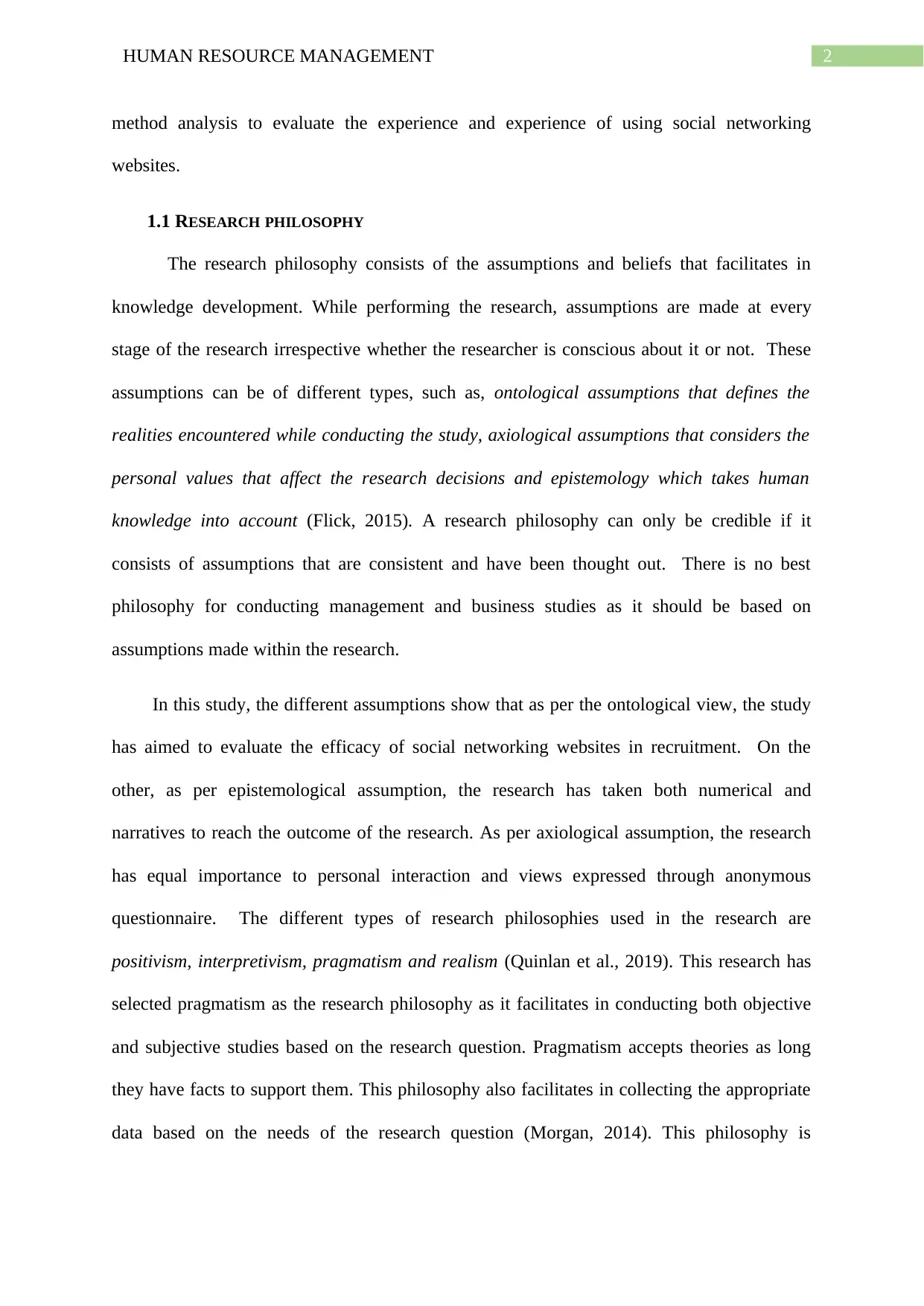
2HUMAN RESOURCE MANAGEMENT
method analysis to evaluate the experience and experience of using social networking
websites.
1.1 RESEARCH PHILOSOPHY
The research philosophy consists of the assumptions and beliefs that facilitates in
knowledge development. While performing the research, assumptions are made at every
stage of the research irrespective whether the researcher is conscious about it or not. These
assumptions can be of different types, such as, ontological assumptions that defines the
realities encountered while conducting the study, axiological assumptions that considers the
personal values that affect the research decisions and epistemology which takes human
knowledge into account (Flick, 2015). A research philosophy can only be credible if it
consists of assumptions that are consistent and have been thought out. There is no best
philosophy for conducting management and business studies as it should be based on
assumptions made within the research.
In this study, the different assumptions show that as per the ontological view, the study
has aimed to evaluate the efficacy of social networking websites in recruitment. On the
other, as per epistemological assumption, the research has taken both numerical and
narratives to reach the outcome of the research. As per axiological assumption, the research
has equal importance to personal interaction and views expressed through anonymous
questionnaire. The different types of research philosophies used in the research are
positivism, interpretivism, pragmatism and realism (Quinlan et al., 2019). This research has
selected pragmatism as the research philosophy as it facilitates in conducting both objective
and subjective studies based on the research question. Pragmatism accepts theories as long
they have facts to support them. This philosophy also facilitates in collecting the appropriate
data based on the needs of the research question (Morgan, 2014). This philosophy is
method analysis to evaluate the experience and experience of using social networking
websites.
1.1 RESEARCH PHILOSOPHY
The research philosophy consists of the assumptions and beliefs that facilitates in
knowledge development. While performing the research, assumptions are made at every
stage of the research irrespective whether the researcher is conscious about it or not. These
assumptions can be of different types, such as, ontological assumptions that defines the
realities encountered while conducting the study, axiological assumptions that considers the
personal values that affect the research decisions and epistemology which takes human
knowledge into account (Flick, 2015). A research philosophy can only be credible if it
consists of assumptions that are consistent and have been thought out. There is no best
philosophy for conducting management and business studies as it should be based on
assumptions made within the research.
In this study, the different assumptions show that as per the ontological view, the study
has aimed to evaluate the efficacy of social networking websites in recruitment. On the
other, as per epistemological assumption, the research has taken both numerical and
narratives to reach the outcome of the research. As per axiological assumption, the research
has equal importance to personal interaction and views expressed through anonymous
questionnaire. The different types of research philosophies used in the research are
positivism, interpretivism, pragmatism and realism (Quinlan et al., 2019). This research has
selected pragmatism as the research philosophy as it facilitates in conducting both objective
and subjective studies based on the research question. Pragmatism accepts theories as long
they have facts to support them. This philosophy also facilitates in collecting the appropriate
data based on the needs of the research question (Morgan, 2014). This philosophy is
⊘ This is a preview!⊘
Do you want full access?
Subscribe today to unlock all pages.

Trusted by 1+ million students worldwide
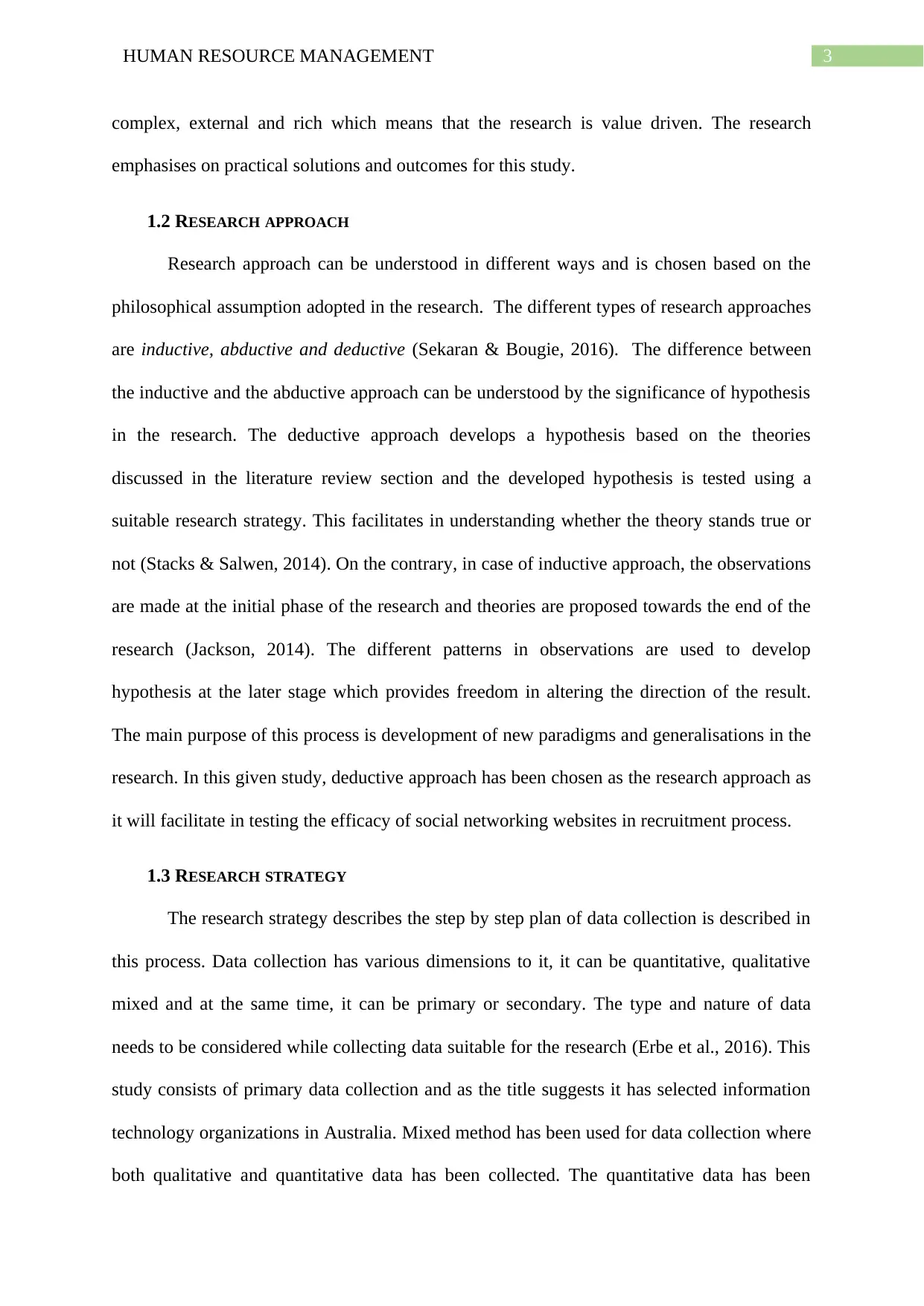
3HUMAN RESOURCE MANAGEMENT
complex, external and rich which means that the research is value driven. The research
emphasises on practical solutions and outcomes for this study.
1.2 RESEARCH APPROACH
Research approach can be understood in different ways and is chosen based on the
philosophical assumption adopted in the research. The different types of research approaches
are inductive, abductive and deductive (Sekaran & Bougie, 2016). The difference between
the inductive and the abductive approach can be understood by the significance of hypothesis
in the research. The deductive approach develops a hypothesis based on the theories
discussed in the literature review section and the developed hypothesis is tested using a
suitable research strategy. This facilitates in understanding whether the theory stands true or
not (Stacks & Salwen, 2014). On the contrary, in case of inductive approach, the observations
are made at the initial phase of the research and theories are proposed towards the end of the
research (Jackson, 2014). The different patterns in observations are used to develop
hypothesis at the later stage which provides freedom in altering the direction of the result.
The main purpose of this process is development of new paradigms and generalisations in the
research. In this given study, deductive approach has been chosen as the research approach as
it will facilitate in testing the efficacy of social networking websites in recruitment process.
1.3 RESEARCH STRATEGY
The research strategy describes the step by step plan of data collection is described in
this process. Data collection has various dimensions to it, it can be quantitative, qualitative
mixed and at the same time, it can be primary or secondary. The type and nature of data
needs to be considered while collecting data suitable for the research (Erbe et al., 2016). This
study consists of primary data collection and as the title suggests it has selected information
technology organizations in Australia. Mixed method has been used for data collection where
both qualitative and quantitative data has been collected. The quantitative data has been
complex, external and rich which means that the research is value driven. The research
emphasises on practical solutions and outcomes for this study.
1.2 RESEARCH APPROACH
Research approach can be understood in different ways and is chosen based on the
philosophical assumption adopted in the research. The different types of research approaches
are inductive, abductive and deductive (Sekaran & Bougie, 2016). The difference between
the inductive and the abductive approach can be understood by the significance of hypothesis
in the research. The deductive approach develops a hypothesis based on the theories
discussed in the literature review section and the developed hypothesis is tested using a
suitable research strategy. This facilitates in understanding whether the theory stands true or
not (Stacks & Salwen, 2014). On the contrary, in case of inductive approach, the observations
are made at the initial phase of the research and theories are proposed towards the end of the
research (Jackson, 2014). The different patterns in observations are used to develop
hypothesis at the later stage which provides freedom in altering the direction of the result.
The main purpose of this process is development of new paradigms and generalisations in the
research. In this given study, deductive approach has been chosen as the research approach as
it will facilitate in testing the efficacy of social networking websites in recruitment process.
1.3 RESEARCH STRATEGY
The research strategy describes the step by step plan of data collection is described in
this process. Data collection has various dimensions to it, it can be quantitative, qualitative
mixed and at the same time, it can be primary or secondary. The type and nature of data
needs to be considered while collecting data suitable for the research (Erbe et al., 2016). This
study consists of primary data collection and as the title suggests it has selected information
technology organizations in Australia. Mixed method has been used for data collection where
both qualitative and quantitative data has been collected. The quantitative data has been
Paraphrase This Document
Need a fresh take? Get an instant paraphrase of this document with our AI Paraphraser
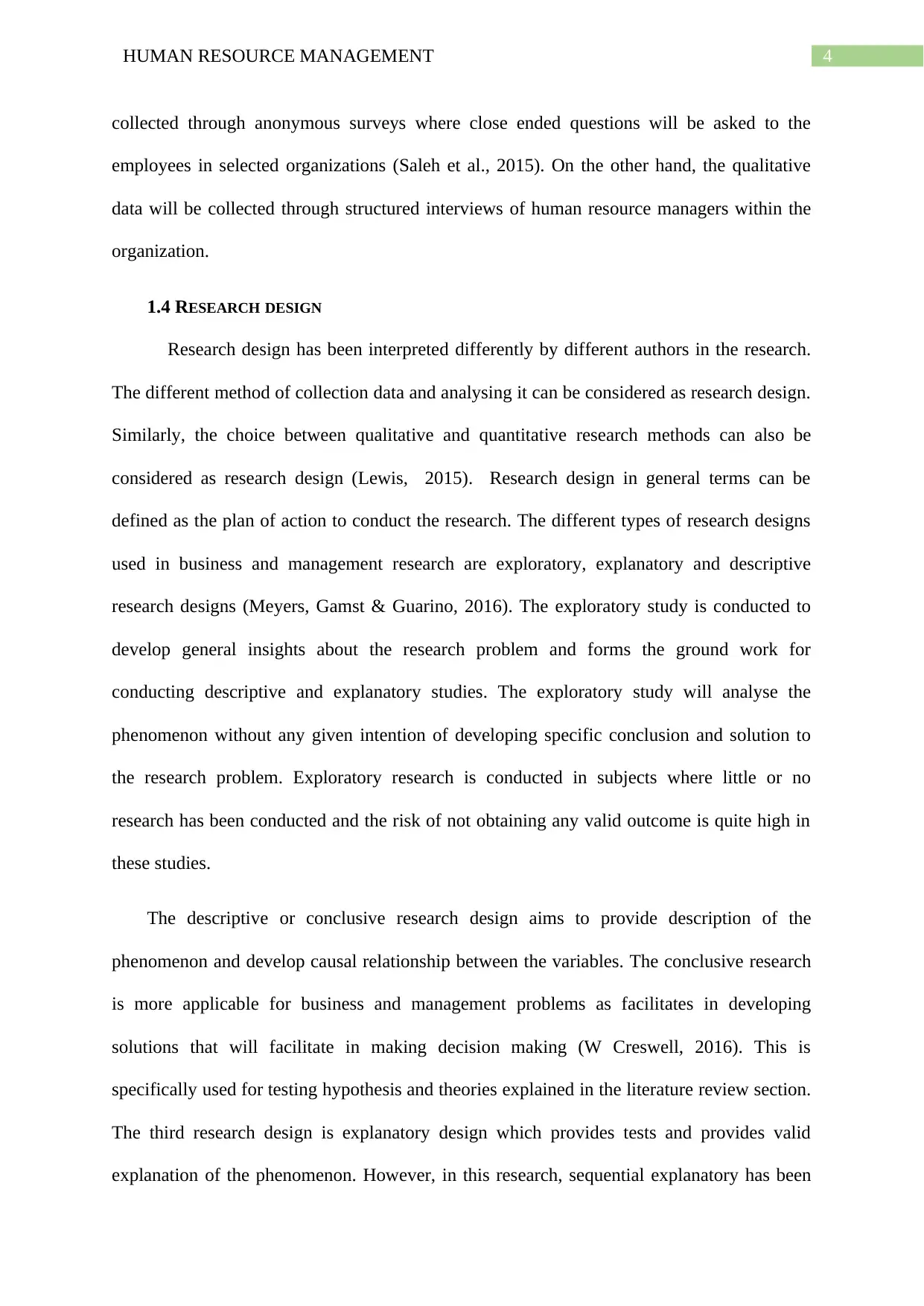
4HUMAN RESOURCE MANAGEMENT
collected through anonymous surveys where close ended questions will be asked to the
employees in selected organizations (Saleh et al., 2015). On the other hand, the qualitative
data will be collected through structured interviews of human resource managers within the
organization.
1.4 RESEARCH DESIGN
Research design has been interpreted differently by different authors in the research.
The different method of collection data and analysing it can be considered as research design.
Similarly, the choice between qualitative and quantitative research methods can also be
considered as research design (Lewis, 2015). Research design in general terms can be
defined as the plan of action to conduct the research. The different types of research designs
used in business and management research are exploratory, explanatory and descriptive
research designs (Meyers, Gamst & Guarino, 2016). The exploratory study is conducted to
develop general insights about the research problem and forms the ground work for
conducting descriptive and explanatory studies. The exploratory study will analyse the
phenomenon without any given intention of developing specific conclusion and solution to
the research problem. Exploratory research is conducted in subjects where little or no
research has been conducted and the risk of not obtaining any valid outcome is quite high in
these studies.
The descriptive or conclusive research design aims to provide description of the
phenomenon and develop causal relationship between the variables. The conclusive research
is more applicable for business and management problems as facilitates in developing
solutions that will facilitate in making decision making (W Creswell, 2016). This is
specifically used for testing hypothesis and theories explained in the literature review section.
The third research design is explanatory design which provides tests and provides valid
explanation of the phenomenon. However, in this research, sequential explanatory has been
collected through anonymous surveys where close ended questions will be asked to the
employees in selected organizations (Saleh et al., 2015). On the other hand, the qualitative
data will be collected through structured interviews of human resource managers within the
organization.
1.4 RESEARCH DESIGN
Research design has been interpreted differently by different authors in the research.
The different method of collection data and analysing it can be considered as research design.
Similarly, the choice between qualitative and quantitative research methods can also be
considered as research design (Lewis, 2015). Research design in general terms can be
defined as the plan of action to conduct the research. The different types of research designs
used in business and management research are exploratory, explanatory and descriptive
research designs (Meyers, Gamst & Guarino, 2016). The exploratory study is conducted to
develop general insights about the research problem and forms the ground work for
conducting descriptive and explanatory studies. The exploratory study will analyse the
phenomenon without any given intention of developing specific conclusion and solution to
the research problem. Exploratory research is conducted in subjects where little or no
research has been conducted and the risk of not obtaining any valid outcome is quite high in
these studies.
The descriptive or conclusive research design aims to provide description of the
phenomenon and develop causal relationship between the variables. The conclusive research
is more applicable for business and management problems as facilitates in developing
solutions that will facilitate in making decision making (W Creswell, 2016). This is
specifically used for testing hypothesis and theories explained in the literature review section.
The third research design is explanatory design which provides tests and provides valid
explanation of the phenomenon. However, in this research, sequential explanatory has been
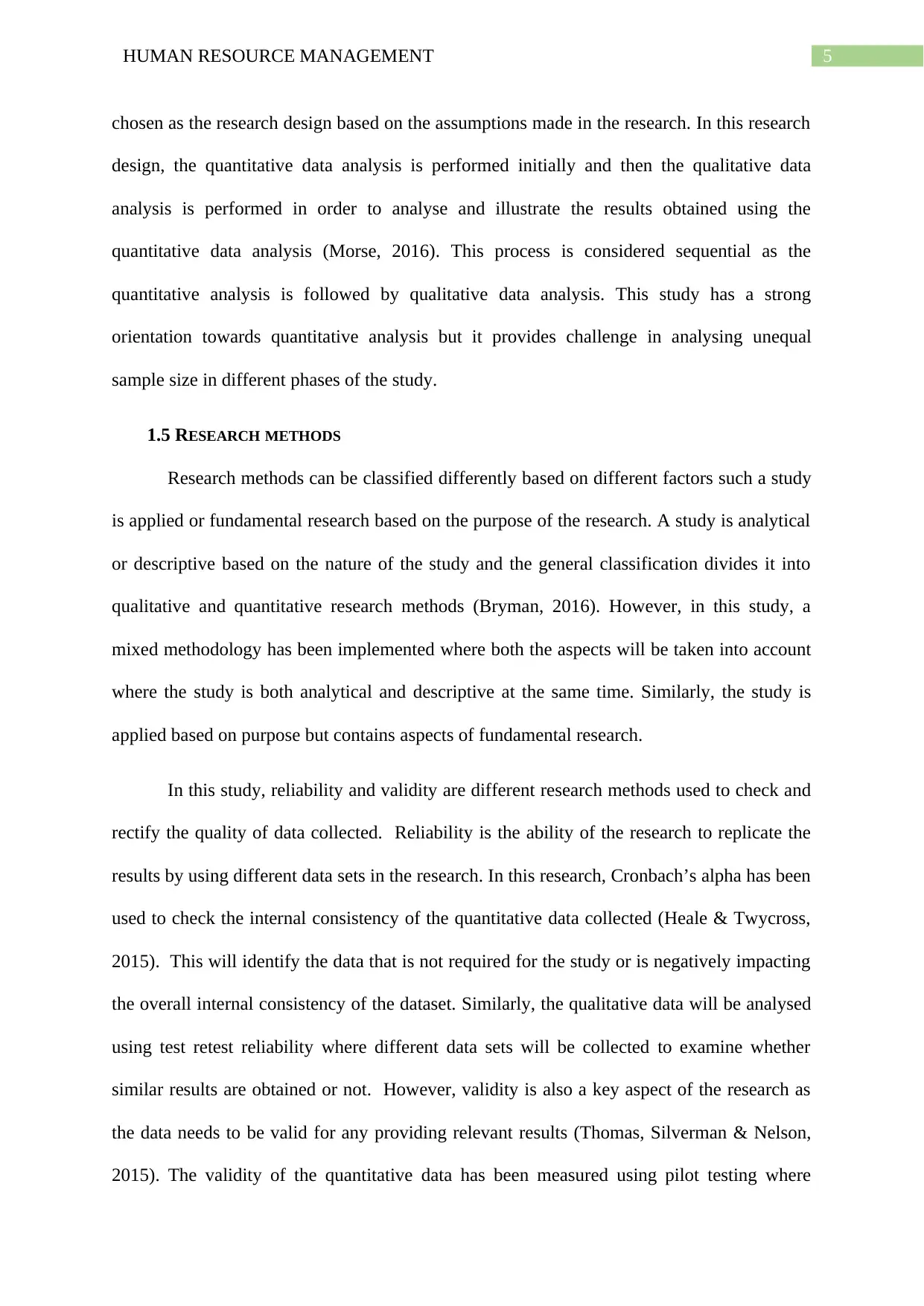
5HUMAN RESOURCE MANAGEMENT
chosen as the research design based on the assumptions made in the research. In this research
design, the quantitative data analysis is performed initially and then the qualitative data
analysis is performed in order to analyse and illustrate the results obtained using the
quantitative data analysis (Morse, 2016). This process is considered sequential as the
quantitative analysis is followed by qualitative data analysis. This study has a strong
orientation towards quantitative analysis but it provides challenge in analysing unequal
sample size in different phases of the study.
1.5 RESEARCH METHODS
Research methods can be classified differently based on different factors such a study
is applied or fundamental research based on the purpose of the research. A study is analytical
or descriptive based on the nature of the study and the general classification divides it into
qualitative and quantitative research methods (Bryman, 2016). However, in this study, a
mixed methodology has been implemented where both the aspects will be taken into account
where the study is both analytical and descriptive at the same time. Similarly, the study is
applied based on purpose but contains aspects of fundamental research.
In this study, reliability and validity are different research methods used to check and
rectify the quality of data collected. Reliability is the ability of the research to replicate the
results by using different data sets in the research. In this research, Cronbach’s alpha has been
used to check the internal consistency of the quantitative data collected (Heale & Twycross,
2015). This will identify the data that is not required for the study or is negatively impacting
the overall internal consistency of the dataset. Similarly, the qualitative data will be analysed
using test retest reliability where different data sets will be collected to examine whether
similar results are obtained or not. However, validity is also a key aspect of the research as
the data needs to be valid for any providing relevant results (Thomas, Silverman & Nelson,
2015). The validity of the quantitative data has been measured using pilot testing where
chosen as the research design based on the assumptions made in the research. In this research
design, the quantitative data analysis is performed initially and then the qualitative data
analysis is performed in order to analyse and illustrate the results obtained using the
quantitative data analysis (Morse, 2016). This process is considered sequential as the
quantitative analysis is followed by qualitative data analysis. This study has a strong
orientation towards quantitative analysis but it provides challenge in analysing unequal
sample size in different phases of the study.
1.5 RESEARCH METHODS
Research methods can be classified differently based on different factors such a study
is applied or fundamental research based on the purpose of the research. A study is analytical
or descriptive based on the nature of the study and the general classification divides it into
qualitative and quantitative research methods (Bryman, 2016). However, in this study, a
mixed methodology has been implemented where both the aspects will be taken into account
where the study is both analytical and descriptive at the same time. Similarly, the study is
applied based on purpose but contains aspects of fundamental research.
In this study, reliability and validity are different research methods used to check and
rectify the quality of data collected. Reliability is the ability of the research to replicate the
results by using different data sets in the research. In this research, Cronbach’s alpha has been
used to check the internal consistency of the quantitative data collected (Heale & Twycross,
2015). This will identify the data that is not required for the study or is negatively impacting
the overall internal consistency of the dataset. Similarly, the qualitative data will be analysed
using test retest reliability where different data sets will be collected to examine whether
similar results are obtained or not. However, validity is also a key aspect of the research as
the data needs to be valid for any providing relevant results (Thomas, Silverman & Nelson,
2015). The validity of the quantitative data has been measured using pilot testing where
⊘ This is a preview!⊘
Do you want full access?
Subscribe today to unlock all pages.

Trusted by 1+ million students worldwide
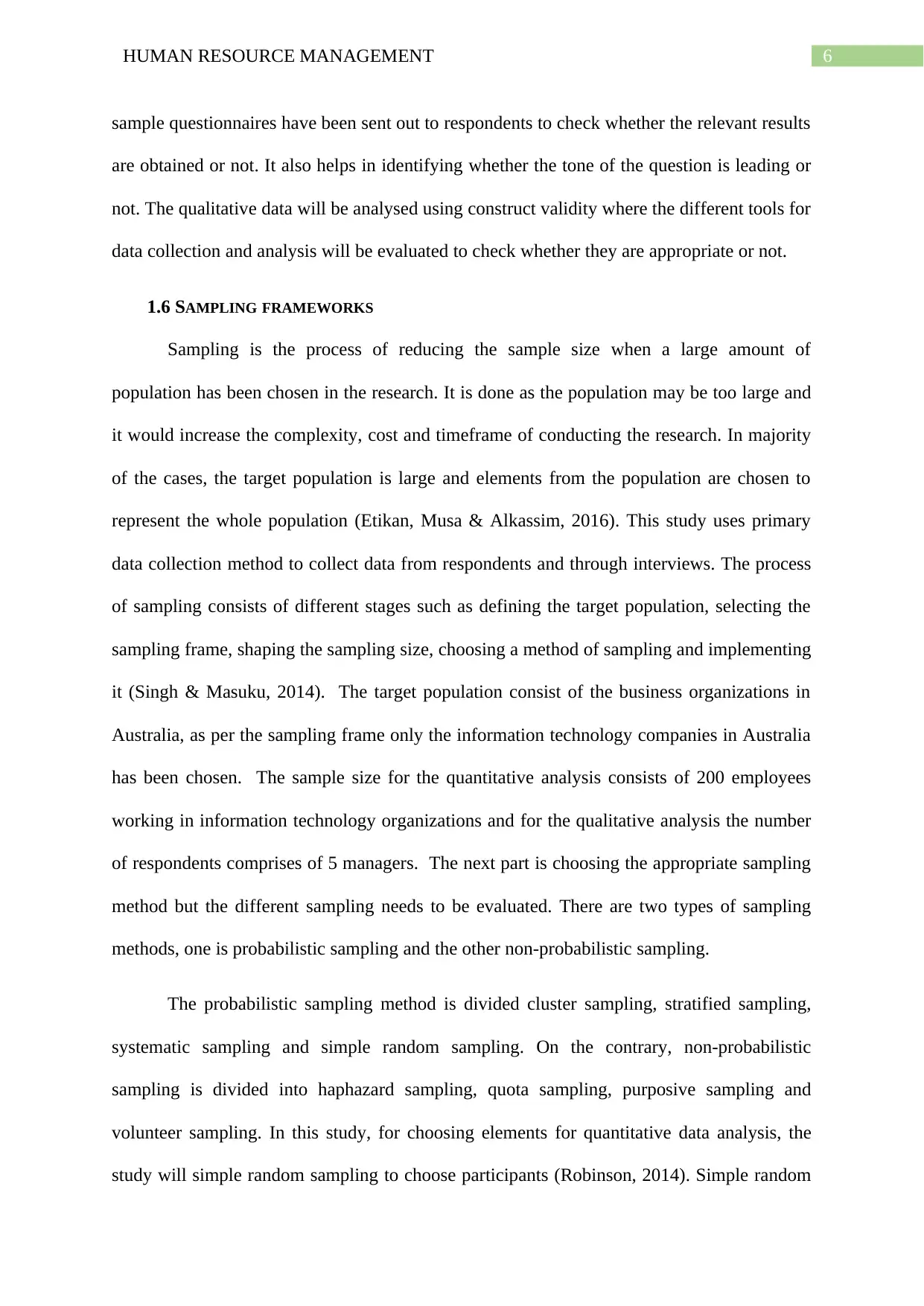
6HUMAN RESOURCE MANAGEMENT
sample questionnaires have been sent out to respondents to check whether the relevant results
are obtained or not. It also helps in identifying whether the tone of the question is leading or
not. The qualitative data will be analysed using construct validity where the different tools for
data collection and analysis will be evaluated to check whether they are appropriate or not.
1.6 SAMPLING FRAMEWORKS
Sampling is the process of reducing the sample size when a large amount of
population has been chosen in the research. It is done as the population may be too large and
it would increase the complexity, cost and timeframe of conducting the research. In majority
of the cases, the target population is large and elements from the population are chosen to
represent the whole population (Etikan, Musa & Alkassim, 2016). This study uses primary
data collection method to collect data from respondents and through interviews. The process
of sampling consists of different stages such as defining the target population, selecting the
sampling frame, shaping the sampling size, choosing a method of sampling and implementing
it (Singh & Masuku, 2014). The target population consist of the business organizations in
Australia, as per the sampling frame only the information technology companies in Australia
has been chosen. The sample size for the quantitative analysis consists of 200 employees
working in information technology organizations and for the qualitative analysis the number
of respondents comprises of 5 managers. The next part is choosing the appropriate sampling
method but the different sampling needs to be evaluated. There are two types of sampling
methods, one is probabilistic sampling and the other non-probabilistic sampling.
The probabilistic sampling method is divided cluster sampling, stratified sampling,
systematic sampling and simple random sampling. On the contrary, non-probabilistic
sampling is divided into haphazard sampling, quota sampling, purposive sampling and
volunteer sampling. In this study, for choosing elements for quantitative data analysis, the
study will simple random sampling to choose participants (Robinson, 2014). Simple random
sample questionnaires have been sent out to respondents to check whether the relevant results
are obtained or not. It also helps in identifying whether the tone of the question is leading or
not. The qualitative data will be analysed using construct validity where the different tools for
data collection and analysis will be evaluated to check whether they are appropriate or not.
1.6 SAMPLING FRAMEWORKS
Sampling is the process of reducing the sample size when a large amount of
population has been chosen in the research. It is done as the population may be too large and
it would increase the complexity, cost and timeframe of conducting the research. In majority
of the cases, the target population is large and elements from the population are chosen to
represent the whole population (Etikan, Musa & Alkassim, 2016). This study uses primary
data collection method to collect data from respondents and through interviews. The process
of sampling consists of different stages such as defining the target population, selecting the
sampling frame, shaping the sampling size, choosing a method of sampling and implementing
it (Singh & Masuku, 2014). The target population consist of the business organizations in
Australia, as per the sampling frame only the information technology companies in Australia
has been chosen. The sample size for the quantitative analysis consists of 200 employees
working in information technology organizations and for the qualitative analysis the number
of respondents comprises of 5 managers. The next part is choosing the appropriate sampling
method but the different sampling needs to be evaluated. There are two types of sampling
methods, one is probabilistic sampling and the other non-probabilistic sampling.
The probabilistic sampling method is divided cluster sampling, stratified sampling,
systematic sampling and simple random sampling. On the contrary, non-probabilistic
sampling is divided into haphazard sampling, quota sampling, purposive sampling and
volunteer sampling. In this study, for choosing elements for quantitative data analysis, the
study will simple random sampling to choose participants (Robinson, 2014). Simple random
Paraphrase This Document
Need a fresh take? Get an instant paraphrase of this document with our AI Paraphraser
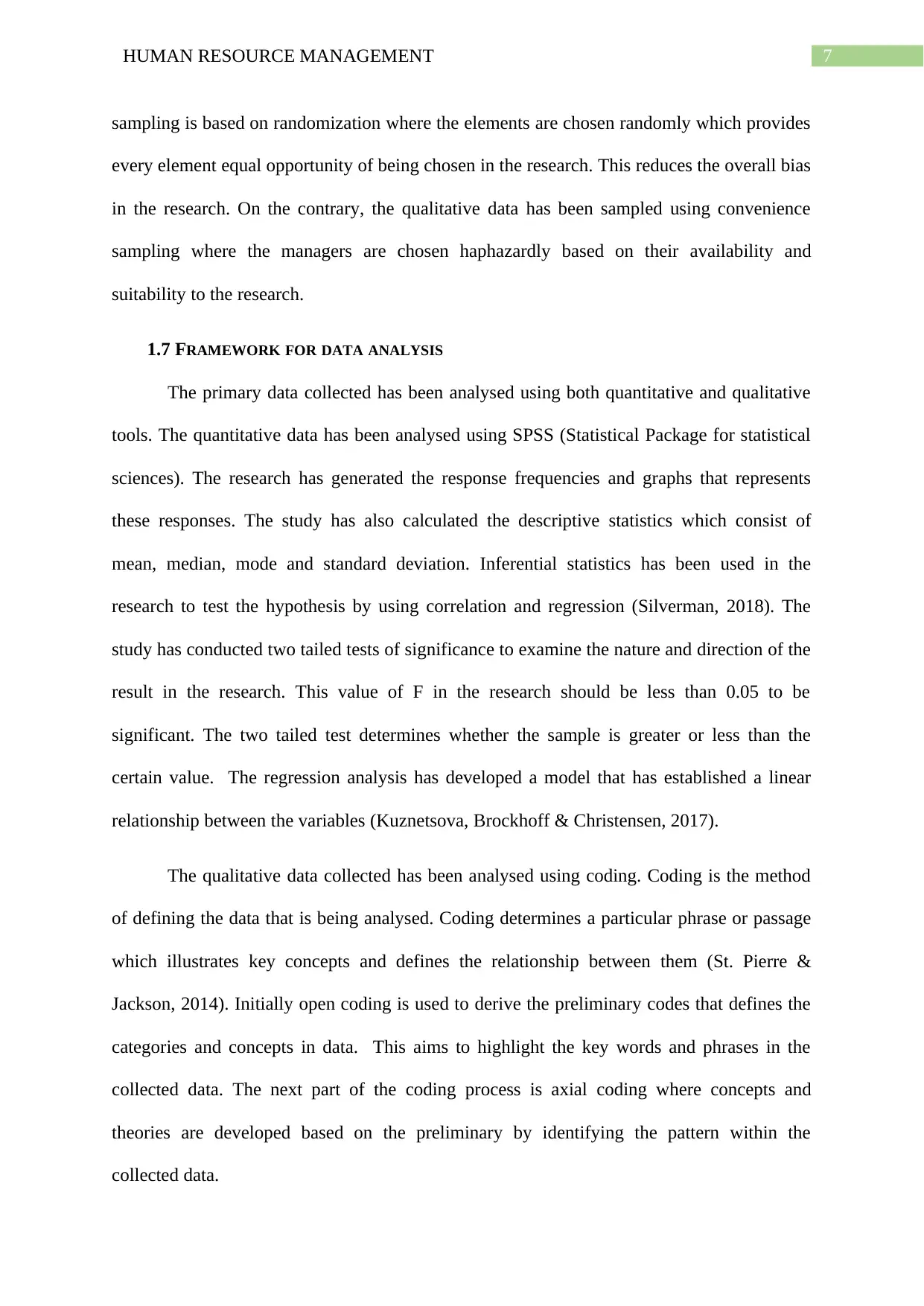
7HUMAN RESOURCE MANAGEMENT
sampling is based on randomization where the elements are chosen randomly which provides
every element equal opportunity of being chosen in the research. This reduces the overall bias
in the research. On the contrary, the qualitative data has been sampled using convenience
sampling where the managers are chosen haphazardly based on their availability and
suitability to the research.
1.7 FRAMEWORK FOR DATA ANALYSIS
The primary data collected has been analysed using both quantitative and qualitative
tools. The quantitative data has been analysed using SPSS (Statistical Package for statistical
sciences). The research has generated the response frequencies and graphs that represents
these responses. The study has also calculated the descriptive statistics which consist of
mean, median, mode and standard deviation. Inferential statistics has been used in the
research to test the hypothesis by using correlation and regression (Silverman, 2018). The
study has conducted two tailed tests of significance to examine the nature and direction of the
result in the research. This value of F in the research should be less than 0.05 to be
significant. The two tailed test determines whether the sample is greater or less than the
certain value. The regression analysis has developed a model that has established a linear
relationship between the variables (Kuznetsova, Brockhoff & Christensen, 2017).
The qualitative data collected has been analysed using coding. Coding is the method
of defining the data that is being analysed. Coding determines a particular phrase or passage
which illustrates key concepts and defines the relationship between them (St. Pierre &
Jackson, 2014). Initially open coding is used to derive the preliminary codes that defines the
categories and concepts in data. This aims to highlight the key words and phrases in the
collected data. The next part of the coding process is axial coding where concepts and
theories are developed based on the preliminary by identifying the pattern within the
collected data.
sampling is based on randomization where the elements are chosen randomly which provides
every element equal opportunity of being chosen in the research. This reduces the overall bias
in the research. On the contrary, the qualitative data has been sampled using convenience
sampling where the managers are chosen haphazardly based on their availability and
suitability to the research.
1.7 FRAMEWORK FOR DATA ANALYSIS
The primary data collected has been analysed using both quantitative and qualitative
tools. The quantitative data has been analysed using SPSS (Statistical Package for statistical
sciences). The research has generated the response frequencies and graphs that represents
these responses. The study has also calculated the descriptive statistics which consist of
mean, median, mode and standard deviation. Inferential statistics has been used in the
research to test the hypothesis by using correlation and regression (Silverman, 2018). The
study has conducted two tailed tests of significance to examine the nature and direction of the
result in the research. This value of F in the research should be less than 0.05 to be
significant. The two tailed test determines whether the sample is greater or less than the
certain value. The regression analysis has developed a model that has established a linear
relationship between the variables (Kuznetsova, Brockhoff & Christensen, 2017).
The qualitative data collected has been analysed using coding. Coding is the method
of defining the data that is being analysed. Coding determines a particular phrase or passage
which illustrates key concepts and defines the relationship between them (St. Pierre &
Jackson, 2014). Initially open coding is used to derive the preliminary codes that defines the
categories and concepts in data. This aims to highlight the key words and phrases in the
collected data. The next part of the coding process is axial coding where concepts and
theories are developed based on the preliminary by identifying the pattern within the
collected data.
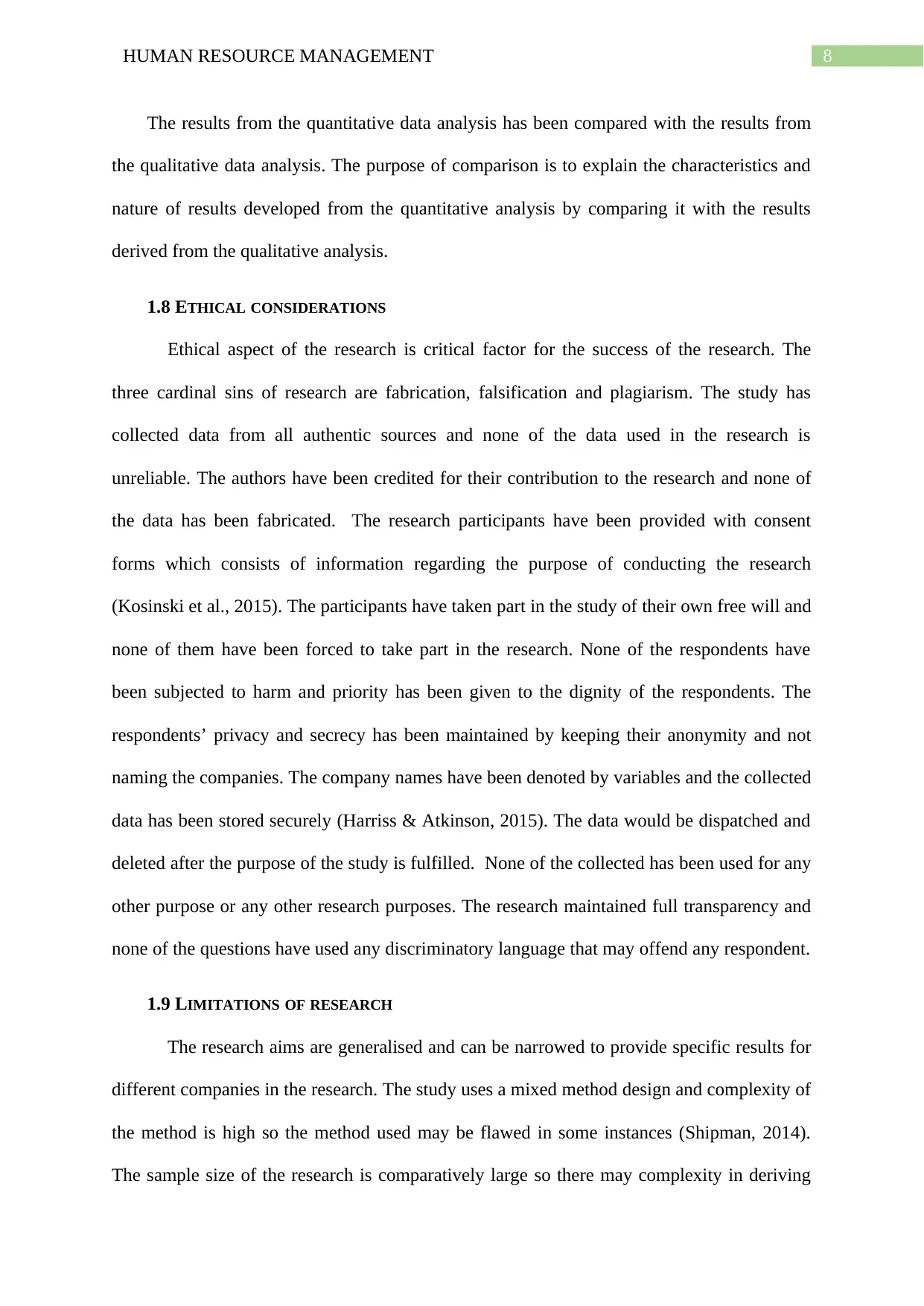
8HUMAN RESOURCE MANAGEMENT
The results from the quantitative data analysis has been compared with the results from
the qualitative data analysis. The purpose of comparison is to explain the characteristics and
nature of results developed from the quantitative analysis by comparing it with the results
derived from the qualitative analysis.
1.8 ETHICAL CONSIDERATIONS
Ethical aspect of the research is critical factor for the success of the research. The
three cardinal sins of research are fabrication, falsification and plagiarism. The study has
collected data from all authentic sources and none of the data used in the research is
unreliable. The authors have been credited for their contribution to the research and none of
the data has been fabricated. The research participants have been provided with consent
forms which consists of information regarding the purpose of conducting the research
(Kosinski et al., 2015). The participants have taken part in the study of their own free will and
none of them have been forced to take part in the research. None of the respondents have
been subjected to harm and priority has been given to the dignity of the respondents. The
respondents’ privacy and secrecy has been maintained by keeping their anonymity and not
naming the companies. The company names have been denoted by variables and the collected
data has been stored securely (Harriss & Atkinson, 2015). The data would be dispatched and
deleted after the purpose of the study is fulfilled. None of the collected has been used for any
other purpose or any other research purposes. The research maintained full transparency and
none of the questions have used any discriminatory language that may offend any respondent.
1.9 LIMITATIONS OF RESEARCH
The research aims are generalised and can be narrowed to provide specific results for
different companies in the research. The study uses a mixed method design and complexity of
the method is high so the method used may be flawed in some instances (Shipman, 2014).
The sample size of the research is comparatively large so there may complexity in deriving
The results from the quantitative data analysis has been compared with the results from
the qualitative data analysis. The purpose of comparison is to explain the characteristics and
nature of results developed from the quantitative analysis by comparing it with the results
derived from the qualitative analysis.
1.8 ETHICAL CONSIDERATIONS
Ethical aspect of the research is critical factor for the success of the research. The
three cardinal sins of research are fabrication, falsification and plagiarism. The study has
collected data from all authentic sources and none of the data used in the research is
unreliable. The authors have been credited for their contribution to the research and none of
the data has been fabricated. The research participants have been provided with consent
forms which consists of information regarding the purpose of conducting the research
(Kosinski et al., 2015). The participants have taken part in the study of their own free will and
none of them have been forced to take part in the research. None of the respondents have
been subjected to harm and priority has been given to the dignity of the respondents. The
respondents’ privacy and secrecy has been maintained by keeping their anonymity and not
naming the companies. The company names have been denoted by variables and the collected
data has been stored securely (Harriss & Atkinson, 2015). The data would be dispatched and
deleted after the purpose of the study is fulfilled. None of the collected has been used for any
other purpose or any other research purposes. The research maintained full transparency and
none of the questions have used any discriminatory language that may offend any respondent.
1.9 LIMITATIONS OF RESEARCH
The research aims are generalised and can be narrowed to provide specific results for
different companies in the research. The study uses a mixed method design and complexity of
the method is high so the method used may be flawed in some instances (Shipman, 2014).
The sample size of the research is comparatively large so there may complexity in deriving
⊘ This is a preview!⊘
Do you want full access?
Subscribe today to unlock all pages.

Trusted by 1+ million students worldwide

9HUMAN RESOURCE MANAGEMENT
the exact results. Moreover, the results obtained are mores specific to the companies in
Australia and may not hold true for other companies from different part of the world.
Moreover, instead of using sequential explanatory method, other research designs may have
yielded better results in the research.
the exact results. Moreover, the results obtained are mores specific to the companies in
Australia and may not hold true for other companies from different part of the world.
Moreover, instead of using sequential explanatory method, other research designs may have
yielded better results in the research.
Paraphrase This Document
Need a fresh take? Get an instant paraphrase of this document with our AI Paraphraser
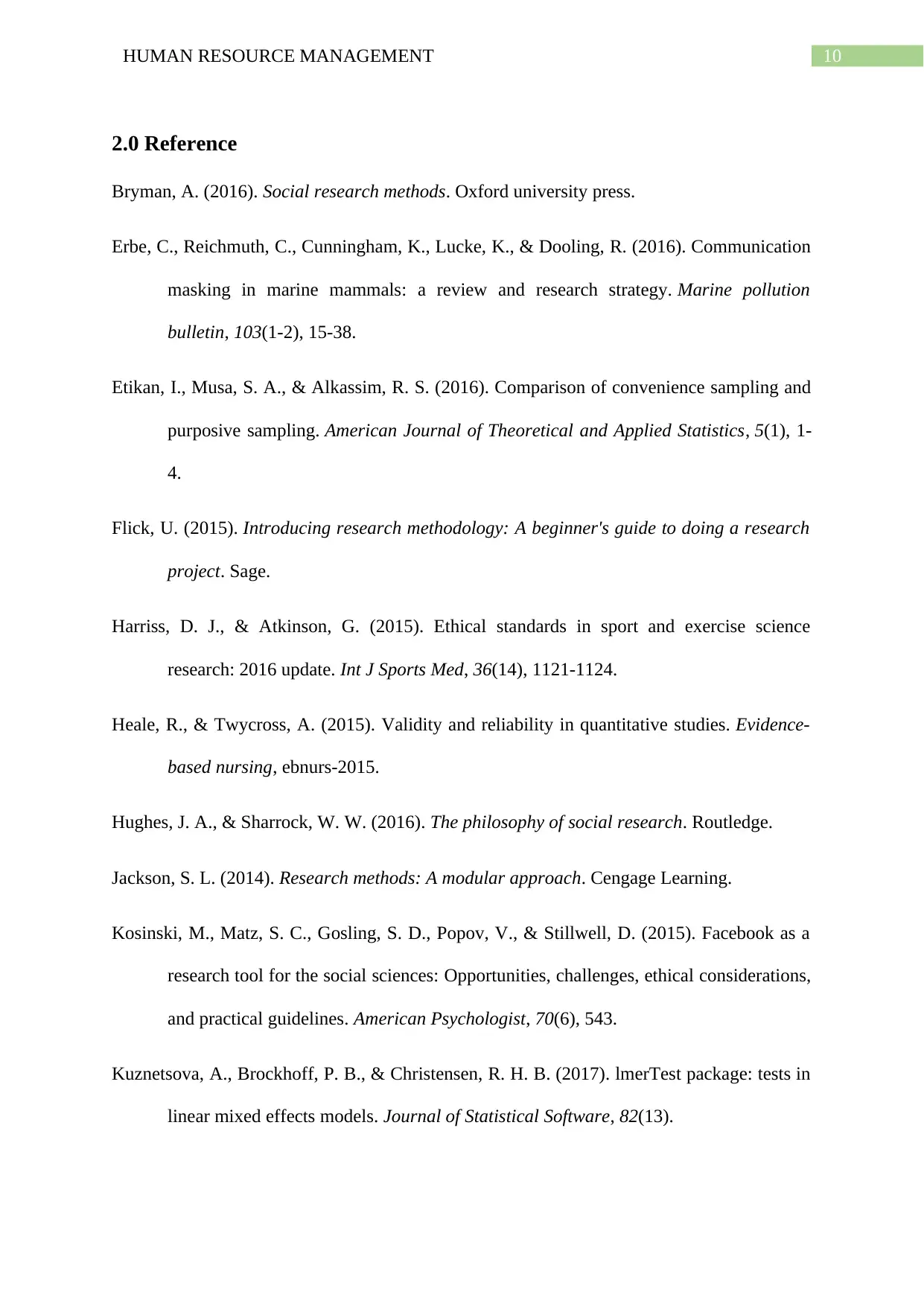
10HUMAN RESOURCE MANAGEMENT
2.0 Reference
Bryman, A. (2016). Social research methods. Oxford university press.
Erbe, C., Reichmuth, C., Cunningham, K., Lucke, K., & Dooling, R. (2016). Communication
masking in marine mammals: a review and research strategy. Marine pollution
bulletin, 103(1-2), 15-38.
Etikan, I., Musa, S. A., & Alkassim, R. S. (2016). Comparison of convenience sampling and
purposive sampling. American Journal of Theoretical and Applied Statistics, 5(1), 1-
4.
Flick, U. (2015). Introducing research methodology: A beginner's guide to doing a research
project. Sage.
Harriss, D. J., & Atkinson, G. (2015). Ethical standards in sport and exercise science
research: 2016 update. Int J Sports Med, 36(14), 1121-1124.
Heale, R., & Twycross, A. (2015). Validity and reliability in quantitative studies. Evidence-
based nursing, ebnurs-2015.
Hughes, J. A., & Sharrock, W. W. (2016). The philosophy of social research. Routledge.
Jackson, S. L. (2014). Research methods: A modular approach. Cengage Learning.
Kosinski, M., Matz, S. C., Gosling, S. D., Popov, V., & Stillwell, D. (2015). Facebook as a
research tool for the social sciences: Opportunities, challenges, ethical considerations,
and practical guidelines. American Psychologist, 70(6), 543.
Kuznetsova, A., Brockhoff, P. B., & Christensen, R. H. B. (2017). lmerTest package: tests in
linear mixed effects models. Journal of Statistical Software, 82(13).
2.0 Reference
Bryman, A. (2016). Social research methods. Oxford university press.
Erbe, C., Reichmuth, C., Cunningham, K., Lucke, K., & Dooling, R. (2016). Communication
masking in marine mammals: a review and research strategy. Marine pollution
bulletin, 103(1-2), 15-38.
Etikan, I., Musa, S. A., & Alkassim, R. S. (2016). Comparison of convenience sampling and
purposive sampling. American Journal of Theoretical and Applied Statistics, 5(1), 1-
4.
Flick, U. (2015). Introducing research methodology: A beginner's guide to doing a research
project. Sage.
Harriss, D. J., & Atkinson, G. (2015). Ethical standards in sport and exercise science
research: 2016 update. Int J Sports Med, 36(14), 1121-1124.
Heale, R., & Twycross, A. (2015). Validity and reliability in quantitative studies. Evidence-
based nursing, ebnurs-2015.
Hughes, J. A., & Sharrock, W. W. (2016). The philosophy of social research. Routledge.
Jackson, S. L. (2014). Research methods: A modular approach. Cengage Learning.
Kosinski, M., Matz, S. C., Gosling, S. D., Popov, V., & Stillwell, D. (2015). Facebook as a
research tool for the social sciences: Opportunities, challenges, ethical considerations,
and practical guidelines. American Psychologist, 70(6), 543.
Kuznetsova, A., Brockhoff, P. B., & Christensen, R. H. B. (2017). lmerTest package: tests in
linear mixed effects models. Journal of Statistical Software, 82(13).
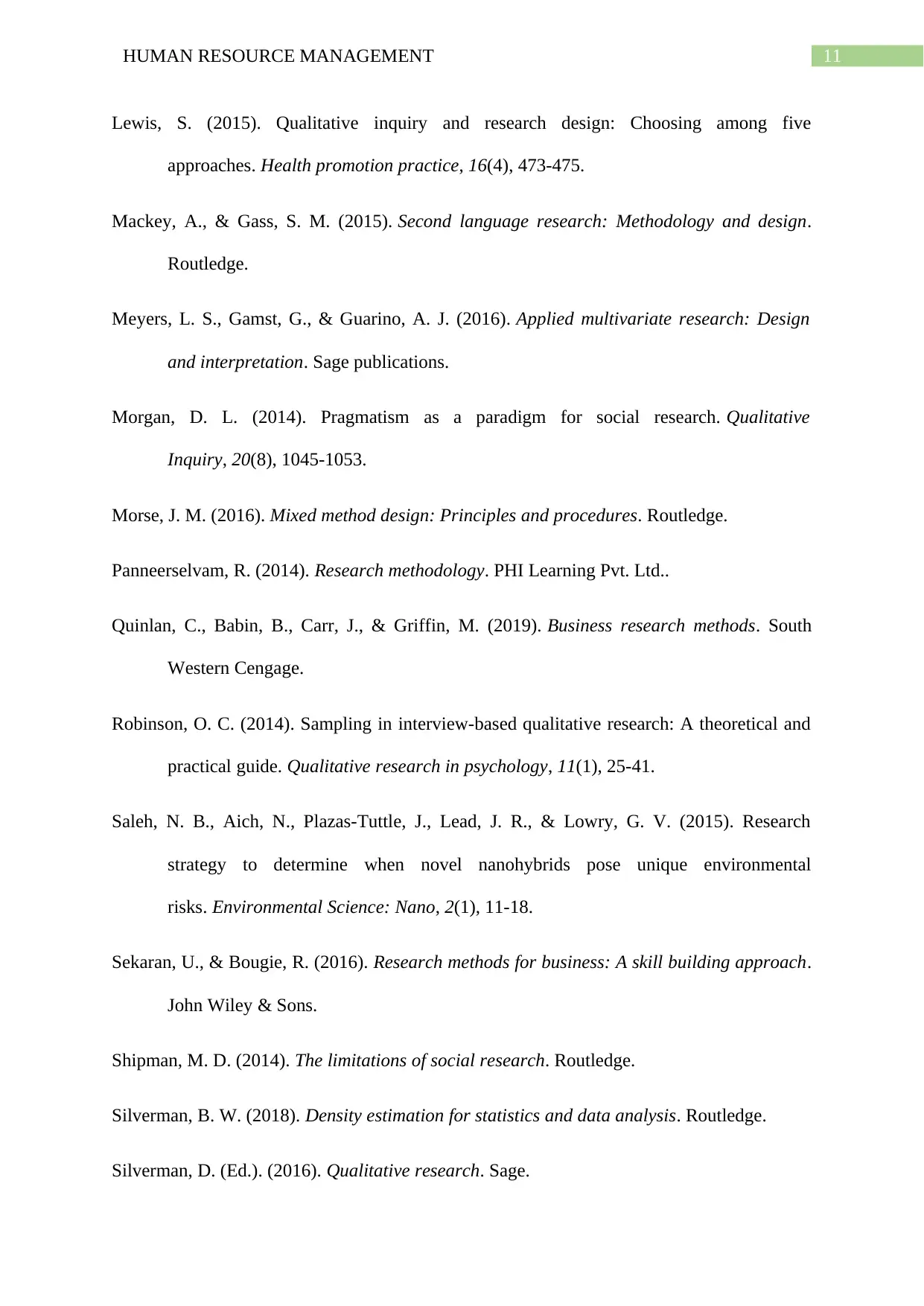
11HUMAN RESOURCE MANAGEMENT
Lewis, S. (2015). Qualitative inquiry and research design: Choosing among five
approaches. Health promotion practice, 16(4), 473-475.
Mackey, A., & Gass, S. M. (2015). Second language research: Methodology and design.
Routledge.
Meyers, L. S., Gamst, G., & Guarino, A. J. (2016). Applied multivariate research: Design
and interpretation. Sage publications.
Morgan, D. L. (2014). Pragmatism as a paradigm for social research. Qualitative
Inquiry, 20(8), 1045-1053.
Morse, J. M. (2016). Mixed method design: Principles and procedures. Routledge.
Panneerselvam, R. (2014). Research methodology. PHI Learning Pvt. Ltd..
Quinlan, C., Babin, B., Carr, J., & Griffin, M. (2019). Business research methods. South
Western Cengage.
Robinson, O. C. (2014). Sampling in interview-based qualitative research: A theoretical and
practical guide. Qualitative research in psychology, 11(1), 25-41.
Saleh, N. B., Aich, N., Plazas-Tuttle, J., Lead, J. R., & Lowry, G. V. (2015). Research
strategy to determine when novel nanohybrids pose unique environmental
risks. Environmental Science: Nano, 2(1), 11-18.
Sekaran, U., & Bougie, R. (2016). Research methods for business: A skill building approach.
John Wiley & Sons.
Shipman, M. D. (2014). The limitations of social research. Routledge.
Silverman, B. W. (2018). Density estimation for statistics and data analysis. Routledge.
Silverman, D. (Ed.). (2016). Qualitative research. Sage.
Lewis, S. (2015). Qualitative inquiry and research design: Choosing among five
approaches. Health promotion practice, 16(4), 473-475.
Mackey, A., & Gass, S. M. (2015). Second language research: Methodology and design.
Routledge.
Meyers, L. S., Gamst, G., & Guarino, A. J. (2016). Applied multivariate research: Design
and interpretation. Sage publications.
Morgan, D. L. (2014). Pragmatism as a paradigm for social research. Qualitative
Inquiry, 20(8), 1045-1053.
Morse, J. M. (2016). Mixed method design: Principles and procedures. Routledge.
Panneerselvam, R. (2014). Research methodology. PHI Learning Pvt. Ltd..
Quinlan, C., Babin, B., Carr, J., & Griffin, M. (2019). Business research methods. South
Western Cengage.
Robinson, O. C. (2014). Sampling in interview-based qualitative research: A theoretical and
practical guide. Qualitative research in psychology, 11(1), 25-41.
Saleh, N. B., Aich, N., Plazas-Tuttle, J., Lead, J. R., & Lowry, G. V. (2015). Research
strategy to determine when novel nanohybrids pose unique environmental
risks. Environmental Science: Nano, 2(1), 11-18.
Sekaran, U., & Bougie, R. (2016). Research methods for business: A skill building approach.
John Wiley & Sons.
Shipman, M. D. (2014). The limitations of social research. Routledge.
Silverman, B. W. (2018). Density estimation for statistics and data analysis. Routledge.
Silverman, D. (Ed.). (2016). Qualitative research. Sage.
⊘ This is a preview!⊘
Do you want full access?
Subscribe today to unlock all pages.

Trusted by 1+ million students worldwide
1 out of 13
Related Documents
Your All-in-One AI-Powered Toolkit for Academic Success.
+13062052269
info@desklib.com
Available 24*7 on WhatsApp / Email
![[object Object]](/_next/static/media/star-bottom.7253800d.svg)
Unlock your academic potential
Copyright © 2020–2025 A2Z Services. All Rights Reserved. Developed and managed by ZUCOL.





